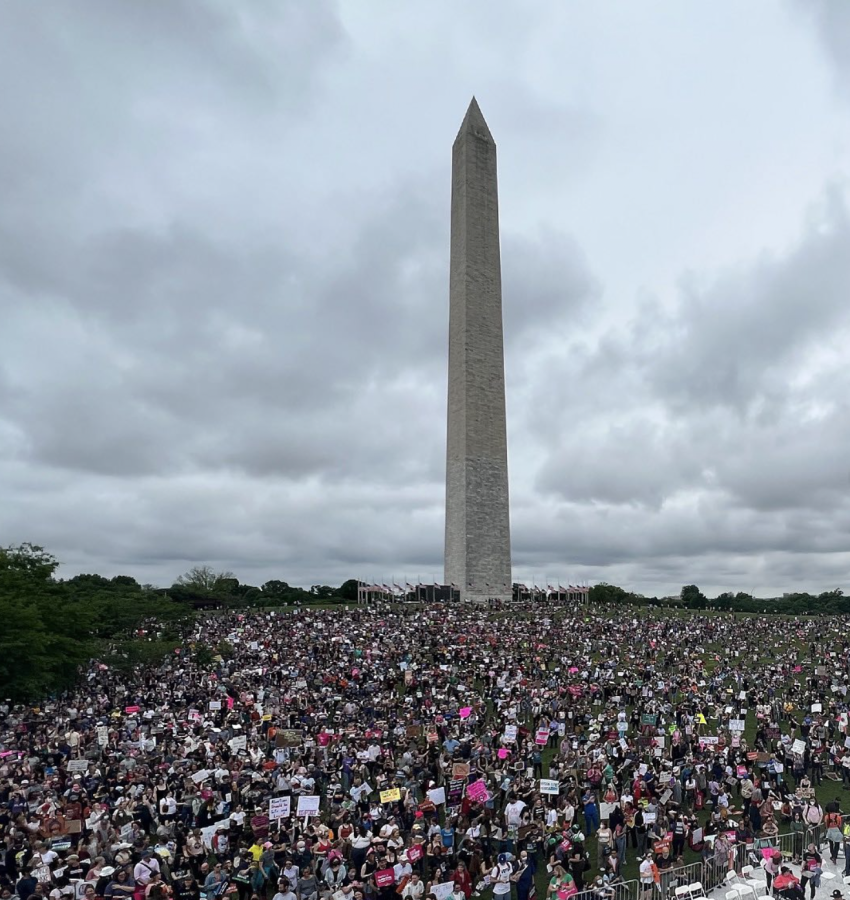Roe v. Wade Update
@ plannedparenthood by photographer Paulo Filguerias
Roughly 1 million people protesting a potential ban on abortion at the Washington Monument.
On May 3rd, a draft of Justice Alito’s opinion on Roe v. Wade was leaked, showing intent to overturn the case. Roe v. Wade was a court decision made in in 1973 that protected womens’ right to an abortion. The implications of this decision are difficult to grasp without understanding the history of what this case has done for countless women in the past 50 years.
According to Encyclopedia Britannica, the story begins with Norma McCorvey—better known as Jane Roe to protect her identity—who initiated the case in 1970 against the district attorney of Dallas at the time, Henry Wade. Norma was pregnant with her third child in 1969 and wished to have an abortion, but was unable to find a facility to do so. In the 1970s, Texas’ laws made abortions illegal unless the pregnancy threatened the mother’s health. However, the Supreme Court ruled (7-2) that the state regulation of abortion was unconstitutional under the 1st, 4th, 9th and 14th amendments. The 14th amendment establishes the right to fair and equal treatment at the state level which the Supreme Court applied to the Constitution’s “right to privacy.” They ruled that outlawing abortion was unconstitutional since it infringed on a woman’s right to privacy from the government.
Since then, Roe v. Wade has come under controversy. Various cases haven’t overturned the case but have narrowed the case in different aspects. according to Encyclopedia Britannica. One of these cases was Planned Parenthood of Southeastern Pennsylvania v. Casey (1992) which ruled that if restricting an abortion caused an “undue burden” on a woman, then it would be unconstitutional. Gonzales v. Carhart (2007) banned a rare abortion procedure called intact dilation and evacuation. Other cases since then such as Whole Woman’s Health v. Hellerstedt (2016) and June Medical Services L.L.C. v. Russo (2020) also ruled in favor of keeping abortions legal.
Despite this, various laws in some states? seem to say the opposite. According to the Guttmacher Institute, 43 states don’t allow an abortion after a certain number of weeks, with the median being around 20 weeks. Texas has the shortest of all time periods, prohibiting abortions after only 6 weeks. The exception to this is if the pregnancy threatens a mother’s life—in which case, an abortion would be allowed.
In total, 33 states prohibit using state funding for abortions, unless not having one threatens the mother’s life, if the pregnancy resulted from rape or incest, and if there is federal funding available. 12 states don’t allow abortion to be covered insurance plans. For women who want to be covered for an abortion, they would have to pay more. 42 states allow hospitals to refuse to perform an abortion and 45 states allow medical workers to refuse to participate in an abortion.
Generally, more people believe that abortions should always be legal or allowed depending on certain circumstances than those who do not. Pew Research Center states, however, that “the public’s attitudes are contingent upon such circumstances as when an abortion takes place during a woman’s pregnancy, whether the pregnancy endangers a woman’s life, and whether a baby would have severe health problems.”
Despite this, popular opinion about abortion hasn’t changed much from the 1970s. A 1975 poll by Gallup found that 21% of people believed abortion should be legal in any circumstance and 22% of people who believed abortion should always be illegal. 54% of people stayed in the middle ground, and responded that abortion should be legal in some circumstances, and not in others.
The leak of a majority court opinion written by Justice Samuel A. Alito, Jr. shows that Roe v. Wade and Parenthood v. Casey might be overturned. The implications of this decision means that the federal protection of abortion for women in the past 50 years will disappear. Whether or not to allow abortion will then be decided by each state. Some states, such as Texas, may ban abortion completely, cutting off legal abortions to millions of women. Some states, like Arkansas, Texas, and Utah have already established trigger laws: laws that will come into action almost immediately if Roe v. Wade is overturned. Right now, the number of states with trigger laws totals 13, with some states such as Kentucky, Missouri and North Dakota making it a felony to perform abortions, unless it’s a medical emergency. Some, who can afford it, might travel to other states to perform an abortion, but for those like Jane Roe, who grew up in impoverished circumstances, this might not be an option.

Kayden came to Bishops in 8th grade and became a staff writer for The Tower this year. He joined The Tower since he wanted to improve his writing, learn...







